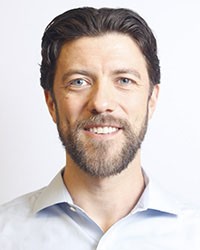
“I believe that the human body was made for movement, which not only keeps us healthy, but also allows us to express ourselves as individuals,” Bosley says.
Traditionally, sports medicine has been about treating injuries. But at Kaiser Permanente, Bosley and colleagues use a forward-thinking preventive approach to sports medicine to reduce the prevalence of injuries.
Bosley and his team at Kaiser Permanente, of course, work with athletes. But they also believe in providing thorough and personalized treatment for all patients.
Bosley particularly enjoys working with those who prefer “less mainstream” sporting activities, such as track and field, cycling, swimming, rowing, wrestling, climbing, yoga and martial arts.
What do you mean by preventive sports medicine?
Minimizing or preventing an injury is similar to fighting off the sniffles. You should listen to your body just like when you’re starting to get a cold, like a tickly throat, you rest and take Vitamin C before it blossoms into a full-blown respiratory illness. Listening to your musculoskeletal system is similar. If you’re sore, or you feel an ache first thing in the morning, you should probably take it easy. Understanding how to use equipment properly and exercise with proper form are also key ways to ward off injury.
What’s the overall goal of sports medicine? What are common misperceptions? What do you want to do to set the record straight?
My goal is simply to help people who desire to be their most authentic selves. People choose activities to express who they are. Misperceptions are when people think that only athletes who play in a popularized sport should see someone in sports medicine. That’s not true. People should be active and exercise to maximize their quality of life.
Ultrasound is being used in sports medicine to guide treatment more precisely. How does this work? What else is new?
Ultrasound is a tool that’s been around since the 1960s. But the technology parallels the smartphone. Phones used to be mounted to the wall. Now, they’re hyper portable. Same with ultrasounds. You can literally bring the machine with you into the exam room and answer specific questions. Let’s say a patient had sudden onset of knee pain after landing during a jump. If the patient can put a finger on the spot, I can directly interrogate the health of that tendon. There’s often no need for an MRI. We can very carefully direct an anesthetic into that suspected injury, which, if it takes away the pain, gives us an immediate diagnosis.
At Kaiser Permanente we feel it’s important to get the patient to the right specialist the first time. This can often be done with digital imaging, an MRI, and video communication during the initial visit.
What does Kaiser Permanente recommend for its members regarding exercise?
I prescribe a simple rule of thumb: Anything is better than nothing. Moderation in all things, including moderation. Brisk walking is an example. You don’t always have to maximally exert yourself. Exercise is medicine. Sometimes a low dose isn’t enough. But if you take too much, sometimes it can be a real problem. You have to find the right dose. The activity doesn’t matter a whole lot. Beyond that, make sure you move well, and then more often, and then increase the intensity and speed.
What are some free and low-cost exercise opportunities in Oakland?
We live in an amazing city with an amazing climate and amazing outdoor resources. It is walkable, bike-able and just getting around is beautiful. We have Lake Merritt in the middle of our city and it is awesome. You can row, paddleboard, canoe, or run and jog around the lake. We’re also surrounded by ring of parks and the hills. It doesn’t matter if you hike, bike, run, walk or even listen to an audio book. Plus, there’s are many public facilities, and local universities, which have classes, tracks and pools that people can use at reasonable rates.
What are some ways to start exercising if one is not in the habit or not in shape?
Start by identifying one simple activity in your day that you could make slightly more active. So, if you’ve never walked around my block, walk around the block once a day. If you commute on BART, you could get off one stop early and walk the rest of the way. If you walk already, you could run a little or take a class somewhere.














